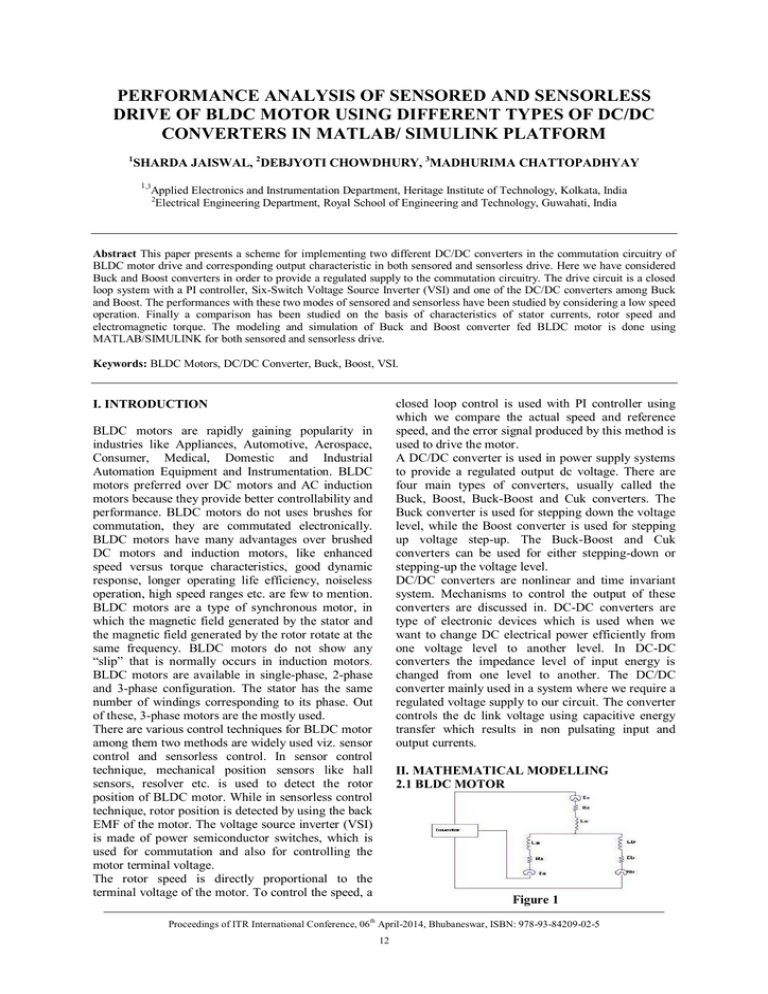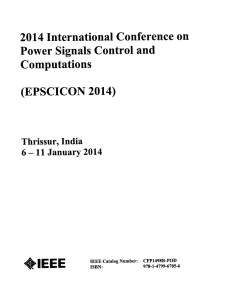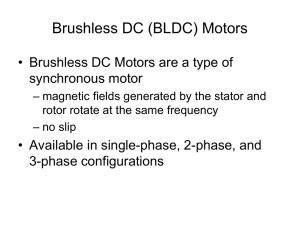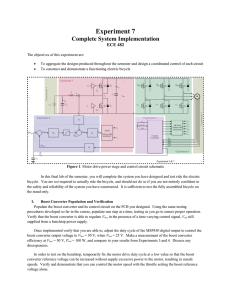performance analysis of sensored and sensorless drive of
advertisement

Performance Analysis Of Sensored And Sensorless Drive Of Bldc Motor Using Different Types Of Dc/Dc Converters In Matlab/ Simulink Platform PERFORMANCE ANALYSIS OF SENSORED AND SENSORLESS DRIVE OF BLDC MOTOR USING DIFFERENT TYPES OF DC/DC CONVERTERS IN MATLAB/ SIMULINK PLATFORM 1 SHARDA JAISWAL, 2DEBJYOTI CHOWDHURY, 3MADHURIMA CHATTOPADHYAY 1,3 Applied Electronics and Instrumentation Department, Heritage Institute of Technology, Kolkata, India 2 Electrical Engineering Department, Royal School of Engineering and Technology, Guwahati, India Abstract This paper presents a scheme for implementing two different DC/DC converters in the commutation circuitry of BLDC motor drive and corresponding output characteristic in both sensored and sensorless drive. Here we have considered Buck and Boost converters in order to provide a regulated supply to the commutation circuitry. The drive circuit is a closed loop system with a PI controller, Six-Switch Voltage Source Inverter (VSI) and one of the DC/DC converters among Buck and Boost. The performances with these two modes of sensored and sensorless have been studied by considering a low speed operation. Finally a comparison has been studied on the basis of characteristics of stator currents, rotor speed and electromagnetic torque. The modeling and simulation of Buck and Boost converter fed BLDC motor is done using MATLAB/SIMULINK for both sensored and sensorless drive. Keywords: BLDC Motors, DC/DC Converter, Buck, Boost, VSI. closed loop control is used with PI controller using which we compare the actual speed and reference speed, and the error signal produced by this method is used to drive the motor. A DC/DC converter is used in power supply systems to provide a regulated output dc voltage. There are four main types of converters, usually called the Buck, Boost, Buck-Boost and Cuk converters. The Buck converter is used for stepping down the voltage level, while the Boost converter is used for stepping up voltage step-up. The Buck-Boost and Cuk converters can be used for either stepping-down or stepping-up the voltage level. DC/DC converters are nonlinear and time invariant system. Mechanisms to control the output of these converters are discussed in. DC-DC converters are type of electronic devices which is used when we want to change DC electrical power efficiently from one voltage level to another level. In DC-DC converters the impedance level of input energy is changed from one level to another. The DC/DC converter mainly used in a system where we require a regulated voltage supply to our circuit. The converter controls the dc link voltage using capacitive energy transfer which results in non pulsating input and output currents. I. INTRODUCTION BLDC motors are rapidly gaining popularity in industries like Appliances, Automotive, Aerospace, Consumer, Medical, Domestic and Industrial Automation Equipment and Instrumentation. BLDC motors preferred over DC motors and AC induction motors because they provide better controllability and performance. BLDC motors do not uses brushes for commutation, they are commutated electronically. BLDC motors have many advantages over brushed DC motors and induction motors, like enhanced speed versus torque characteristics, good dynamic response, longer operating life efficiency, noiseless operation, high speed ranges etc. are few to mention. BLDC motors are a type of synchronous motor, in which the magnetic field generated by the stator and the magnetic field generated by the rotor rotate at the same frequency. BLDC motors do not show any “slip” that is normally occurs in induction motors. BLDC motors are available in single-phase, 2-phase and 3-phase configuration. The stator has the same number of windings corresponding to its phase. Out of these, 3-phase motors are the mostly used. There are various control techniques for BLDC motor among them two methods are widely used viz. sensor control and sensorless control. In sensor control technique, mechanical position sensors like hall sensors, resolver etc. is used to detect the rotor position of BLDC motor. While in sensorless control technique, rotor position is detected by using the back EMF of the motor. The voltage source inverter (VSI) is made of power semiconductor switches, which is used for commutation and also for controlling the motor terminal voltage. The rotor speed is directly proportional to the terminal voltage of the motor. To control the speed, a II. MATHEMATICAL MODELLING 2.1 BLDC MOTOR Figure 1 Proceedings of ITR International Conference, 06th April-2014, Bhubaneswar, ISBN: 978-93-84209-02-5 12 Performance Analysis Of Sensored And Sensorless Drive Of Bldc Motor Using Different Types Of Dc/Dc Converters In Matlab/ Simulink Platform A three phase, star connected BLDC motor can be described by a set of differential equations[21]. The equations are achieved using basic circuit analysis of the above per phase model. The equations are as follows: Va = Ia(t)Ra + La.dIa/dt + Ea(t) (1) Vb = Ib(t)Rb + Lb.dIb/dt + Eb(t) (2) Vc = Ic(t)Rc + Lc.dIc/dt + Ec(t) (3) Where V, I and E are the voltage, current and back emfs of phase A, B, C. R and L are the resistance and inductance of each phase respectively. III. DETAILS EXPERIMENTAL MATLAB/SIMULINK software is used to simulate the close loop models. The closed loop model for both sensored and sensorless system with Buck and Boost fed BLDC motor are shown below. In all cases the input voltage is 48 Volt DC. The reference speed is given 100 rpm. All the systems considered here are closed loop system, which uses a PI controller for speed control of BLDC motor, a six-switch voltage source inverter made of MOSFETs for commutation purpose, and either a Buck converter or Boost Converter. The simulink model for Buck fed BLDC motor with sensored and sensorless drive is shown in figure 4a and figure 5a respectively and for Boost fed BLDC motor with sensored and sensorless drive is shown in figure.6a and figure 7a respectively. Different characteristics curve for all the above mentioned models is shown below of their respective simulation diagram. 2.2. DC/DC Converter: Buck Converter IV. RESULTS AND DISCUSSIONS Figure 2 It is also known as step-down converter. The buck converter is used to lower the input voltage. The circuit diagram for a buck converter is shown in figure 2. The waveform is applied to the low pass LC filter, Va is the square wave having average value of DVin, where D is the switching cycle of the switch. The low pass filter removes all the high frequency components from Va, and the output becomes only DC component. The value of output voltage of the buck converter is given as Vout = DVin (4) Fig. 4a: Buck Fed BLDC Motor (Sensored) Outputs Boost Converter Figure 3 It is also known as step-up converter. The boost converter is used to raise the value of input voltage. The circuit diagram is shown in figure 3. At first, the inductor L is charges when the switch is closed. When we open the switch, it discharges through capacitor C, which again slowly discharges through the load RL. The value of output voltage for boost converter is given as Vout = Vin/(1-D) (5) Fig. 4b: Plot for Stator Currents and Electromagnetic Torque Proceedings of ITR International Conference, 06th April-2014, Bhubaneswar, ISBN: 978-93-84209-02-5 13 Performance Analysis Of Sensored And Sensorless Drive Of Bldc Motor Using Different Types Of Dc/Dc Converters In Matlab/ Simulink Platform Fig.6a: Boost fed BLDC Motor (Sensored) Outputs Fig. 4c: Plot for Rotor Speed Fig 5a: Buck Fed BLDC Motor (Sensorless) Outputs Fig.6b. Plot for Stator Currents and Electromagnetic Torque Fig.6c. Plot for Rotor Speed Fig.5b: Plot for Stator Currents and Electromagnetic Torque Fig.5c: Plot for Rotor Speed Fig.7a: Boost Fed BLDC Motor (Sensorless) Outputs Proceedings of ITR International Conference, 06th April-2014, Bhubaneswar, ISBN: 978-93-84209-02-5 14 Performance Analysis Of Sensored And Sensorless Drive Of Bldc Motor Using Different Types Of Dc/Dc Converters In Matlab/ Simulink Platform works fine for both sensored and sensorless system after making this comparative analysis The simulation results obtained in this paper can be used to develop real time circuitry REFERENCES [1] Ashwini M. Welekar, A. A. Apte, “Development of Brushless DC Motor Drive”, IOSR Journal of Electrical and Electronics Engineering (IOSR-JEEE) e-ISSN: 2278-1676, p-ISSN: 2320-3331 PP 12-18 www.iosrjournals. [2] Devisree Sasi, Jisha Kuruvilla P, “Modelling and Simulation of SVPWM Inverter fed Permanent Magnet Brushless DC Motor Drive”, International Journal of Advanced Research in Electrical, Electronics and Instrumentation Engineering Vol. 2, Issue 5, May 2013. [3] Debjyoti Chowdhury, Madhurima Chattopadhyay, Priyanka Roy, “Modelling and Simulation of Cost Effective Sensorless Drive for Brushless DC Motor”, International Conference on Computational Intelligence: Modelling, Techniques and Applications (CIMTA-2013), Procedia Technology 10 (2013), 279-286. [4] Firdaus F. Belim, Chirag K. Vibhakar, Bharti B, Parmar, Kishan J. Bhayani, “ Improve power quality of BLDC motor using Buck DC-DC converter”, International Journal of Application or Innovation in Engineering & Management (IJAIEM), ISSN 2319 – 4847. [5] Preetha Philip, Dr. Meenakshy K, “Modelling Of Brushless DC Motor Drive Using Sensored And Sensorless Control back EMF zero crossing detection”, International Journal of Emerging Technology and Advanced Engineering, ISSN 2250- 2459, Volume 2, Issue 8, August 2012. [6] C.Umayal, S.Rama Reddy, “Implementation of Bridgeless Boost Converter Fed PMBLDC Motor Drive Using PIC”, International Journal of Energy Engineering, IJEE Vol. 2 No. 1, 2012 PP. 15-21 [7] Rheesabh Dwivedi, Dr. Sanjeev Singh, “Parametric variation analysis of buck-boost converter for constant voltage applications”, 2nd International Conference on Role of Technology in Nation Building (ICRTNB-2013) ISBN: 97881925922-1-3 [8] S. Prakash, R. Dhanasekaran, “Modelling and Simulation of Closed Loop Controlled Buck Converter Fed Pmbldc Drive System”, Research Journal of Applied Sciences, Engineering and Technology 3(4): 284-289, 2011, published: April 20, 2011 [9] [9] Bikram Das, Suvamit Chakraborty, Abanishwar Chakraborti, Prabir Ranjan Kasari, “Performance Analysis of BLDC Motor Using Basic Switching Converters”, International Journal of Innovative Technology and Exploring Engineering (IJITEE), ISSN: 2278-3075, Volume-2, Issue-1, December 2012. Fig.7a. Plot for Stator Currents and Electromagnetic Torque Fig.7c. Plot for Rotor Speed CONCLUSIONS In this paper, closed loop models for sensored and sensorless system with Buck, Boost fed BLDC motor are modeled and simulated using MATLAB/ SIMULINK. We have got here four graphs , two for Buck fed BLDC motor for both sensored and sensorless drive and two for Boost fed BLDC motor for both sensored and sensorless drive. We can see from the graphs that that stator current, electromagnetic torque and rotor speed characteristics for both Buck and Boost converter fed BLDC motor for sensored system replicate the same characteristics for Buck and Boost fed BLDC motor for sensorless system. We can hence conclude that these converters [10] Vashist Bist, Bhim Singh, “An Adjustable Speed PFC Bridgeless Buck-Boost Converter Fed BLDC Motor Drive”, IEEE, Published June 6, 2013. [11] H. Guldemir, “Modeling and Sliding Mode Control of DcDc Buck-Boost Converter”, 6th International Advanced Technologies Symposium (IATS’11), 16-18 May 2011, Elazig, Turkey [12] M.Vellaiyarasi, K. Esakki Shenbaga Loga, J. Jasper Gnana Chandran, “Interleaved Buck Boost Converter Fed DC Motor.” Proceedings of ITR International Conference, 06th April-2014, Bhubaneswar, ISBN: 978-93-84209-02-5 15 Performance Analysis Of Sensored And Sensorless Drive Of Bldc Motor Using Different Types Of Dc/Dc Converters In Matlab/ Simulink Platform [13] S.Prakash, R.Dhanasekaran, “Interleaved Buck Converter Fed PMBLDC Drive System”, International Journal of Technology And Engineering Science, Vol1(6), pp10431048, Sept 2013 [18] A. Purna Chandra Rao, Y. P. Obulesh, Ch. Sai Babu, “Mathematical Modelling of BLDC motor with Closed Loop Control using PID controllers under various loading conditions”, ARPN Journal of Engineering and Applied Sciences, Vol. 7, No. 10, October 2012 [14] C.Umayal, S.Rama Reddy, “Modeling and Simulation of Closed Loop Controlled PFC Half Bridge Converter Fed PMBLDC Motor using Simulink”, International Journal of Electrical Engineering, ISSN 0974-2158 Volume 4, Number 3(2011), pp. 375-387. [19] Mohsen Ebadpour, Mohammad Reza Feyzi, Mohammad Bagher Bannae Sharifian, Mohammad Reza Alizadeh Pahlavani, “A Simple Position Sensorless Control Strategy for Radial Flux Brushless DC Motor Using Single Current Sensor”, Journal of Basic and Applied Scientific Research, J. Basic. Appl. Sci. Res., 2(5)4529-4541, 2012 [15] Dal Y. Ohm, Jae H. Park, “About Commutation and Current Control Methods for Brushless Motors”, 29th Annual IMCSD symposium, San Jose, July 26- 29, 1999. [20] Rizanaliah Kasim, Khairatul Akmal Ismail, Auzani Jidin, Norhazilina Bahari, “Modelling and Simulation of Brushless DC Machines”, ICGWBT2012, Ahmed Dahlan University, March 23- 24, 2012. [16] Ajay Mishra, Arti Bhandakkar, “Simulation Model of Buck Converter Closed System Using PMBLDC Drive”, Int. Journal of Engineering Research and Applications, Vol. 3, Issue 5, Sep-Oct 2013, pp. 377-383. [21] Y. V. Aruna, A. Mallikarjuna Prasad, E. Ramakrishna, “Review of Sensor and Sensorless Control Topologies for a Four-Switch Inverter Fed Permanent Magnet Brushless DC Motor”, Int. Journal of Engineering Research and Applictions, ISSN: 2248-9622, Vol. 3, Issue 5, Sep-Oct 2013, pp. 1222- 1228. [17] Hemchand Immaneni, “Mathematical Modelling and Position Control of Brushless DC motor”, International Journal of Engineering Research and Applictions, Vol. 3, Issue 3, Mat-June 2013, pp. 1050-1057. Proceedings of ITR International Conference, 06th April-2014, Bhubaneswar, ISBN: 978-93-84209-02-5 16



